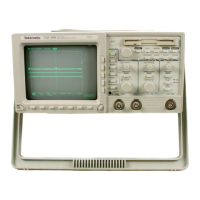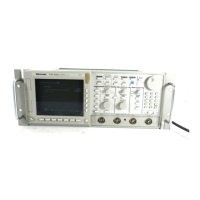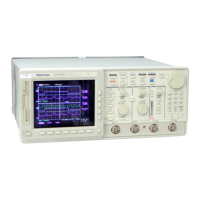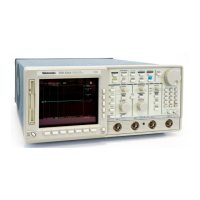Glossary
Glossary–2
TDS 340A, TDS 360 & TDS 380 User Manual
Average Acquisition Mode
In this mode the oscilloscope acquires and displays a waveform that is the
averaged result of several acquisitions. This reduces the apparent noise. The
oscilloscope acquires data as in the sample mode and then averages it
according to a specified number of averages.
Cursors
Paired markers that you can use to make measurements between two
waveform locations. The oscilloscope displays the values (expressed in volts
or time) of the position of the active cursor and the distance between the two
cursors.
DC Coupling
A mode that passes both AC and DC signal components to the circuit.
Available for both the trigger system and the vertical system.
Digital Real-Time Digitizing
A digitizing technique that samples the input signal with a sample frequency
of four to five times the oscilloscope bandwidth. Combined with (sinx)/x
interpolation, all frequency components of the input up to the bandwidth are
accurately displayed.
Digitizing
The process of converting a continuous analog signal such as a waveform to
a set of discrete numbers representing the amplitude of the signal at specific
points in time.
Edge Trigger
Triggering occurs when the oscilloscope detects the source passing through a
specified voltage level in a specified direction (the trigger slope).
Envelope Acquisition Mode
A mode in which the oscilloscope acquires and displays a waveform that
shows the variation extremes of several acquisitions.
Fast Fourier Transform (FFT)
An algorithm used to transform a time-domain waveform into a frequency-
domain waveform. The frequency-domain waveform shows the spectral
content of the time-domain waveform.
Gated Measurements
A feature that lets you limit automated measurements to a specified portion
of the waveform. You define the area of interest using the vertical cursors.
GPIB (General Purpose Interface Bus)
An interconnection bus and protocol that allows you to connect multiple
instruments in a network under the control of a controller. Also known as
IEEE 488 bus. It transfers data with eight parallel data lines, five control
lines, and three handshake lines.

